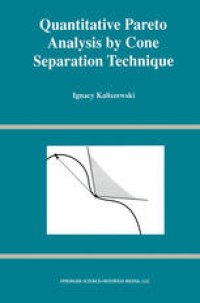
Ebook: Quantitative Pareto Analysis by Cone Separation Technique
Author: Ignacy Kaliszewski (auth.)
- Tags: Operation Research/Decision Theory, Applications of Mathematics, Operations Research Management Science, Mathematical Modeling and Industrial Mathematics, Optimization
- Year: 1994
- Publisher: Springer US
- Edition: 1
- Language: English
- pdf
This work results from my interest in the field of vector optimiza tion. I stumbled first upon this subject in 1982 during my six months visit to the Istituto di Elaborazione della Informazione in Pisa, Italy, supported by a fellowship of the (Italian) Consiglio Nationale delle Richerche. I was attracted then by a gap between vector optimiza tion used to serve as a formal model for multiple objective decision problems and the decision problems themselves, the gap nonexis tent in scalar optimization. Roughly speaking, vector optimization provides methods for ranking decisions according to a partial order whereas decision making requires a linear ordering of decisions. The book deals with vector optimization. However, vector opti mization is considered here not only as a topic of research in itself but also as a basic tool for decision making. In consequence, all results presented here are aimed at exploiting and understanding the structure of elements (decisions) framed by a vector optimiza tion problem with the underlying assumption that the results should be interpretable in terms and applicable in the context of decision making. Computational tractability of results is therefore of special concern throughout this book. A unified framework for presentation is offered by the Cone Sep aration Technique (CST) founded on the notion of cone separation.
This monograph presents interactive mathematics within a self-contained framework, the cone separation technique. This framework affords a unified approach to multiple objective decision problems and their most common model, the vector optimization problem, regardless of their linear, discrete, continuous, convex, or nonconvex nature. With this approach, the analysis of relations between efficient decisions is significantly broadened, new facts are identified and proved.
The cone separation technique gives the decision maker or researcher better methods for analyzing potential efficiency solutions. Specifically, the framework can add any of the following to a solution:
- a simple way of creating hierarchical structures over sets of efficient decisions;
- a way of visualizing the decision making process by a method of graphic approximation;
- a method to calculate trade-offs and gain-to-loss ratios; and
- sensitivity analysis of efficient solutions with respect to perturbation analysis.
This monograph presents interactive mathematics within a self-contained framework, the cone separation technique. This framework affords a unified approach to multiple objective decision problems and their most common model, the vector optimization problem, regardless of their linear, discrete, continuous, convex, or nonconvex nature. With this approach, the analysis of relations between efficient decisions is significantly broadened, new facts are identified and proved.
The cone separation technique gives the decision maker or researcher better methods for analyzing potential efficiency solutions. Specifically, the framework can add any of the following to a solution:
- a simple way of creating hierarchical structures over sets of efficient decisions;
- a way of visualizing the decision making process by a method of graphic approximation;
- a method to calculate trade-offs and gain-to-loss ratios; and
- sensitivity analysis of efficient solutions with respect to perturbation analysis.
Content:
Front Matter....Pages i-xiv
Introduction....Pages 1-6
Basic Elements....Pages 7-19
Cones, Efficiency and Proper Efficiency — A General Setting....Pages 21-39
Proper Efficiency with Respect to R + k ....Pages 41-59
Quantitative Pareto Analysis....Pages 61-130
Substantial Efficiency....Pages 131-143
Computational Tractability of the Quantitative Pareto Analysis....Pages 145-147
Back Matter....Pages 149-160
This monograph presents interactive mathematics within a self-contained framework, the cone separation technique. This framework affords a unified approach to multiple objective decision problems and their most common model, the vector optimization problem, regardless of their linear, discrete, continuous, convex, or nonconvex nature. With this approach, the analysis of relations between efficient decisions is significantly broadened, new facts are identified and proved.
The cone separation technique gives the decision maker or researcher better methods for analyzing potential efficiency solutions. Specifically, the framework can add any of the following to a solution:
- a simple way of creating hierarchical structures over sets of efficient decisions;
- a way of visualizing the decision making process by a method of graphic approximation;
- a method to calculate trade-offs and gain-to-loss ratios; and
- sensitivity analysis of efficient solutions with respect to perturbation analysis.
Content:
Front Matter....Pages i-xiv
Introduction....Pages 1-6
Basic Elements....Pages 7-19
Cones, Efficiency and Proper Efficiency — A General Setting....Pages 21-39
Proper Efficiency with Respect to R + k ....Pages 41-59
Quantitative Pareto Analysis....Pages 61-130
Substantial Efficiency....Pages 131-143
Computational Tractability of the Quantitative Pareto Analysis....Pages 145-147
Back Matter....Pages 149-160
....